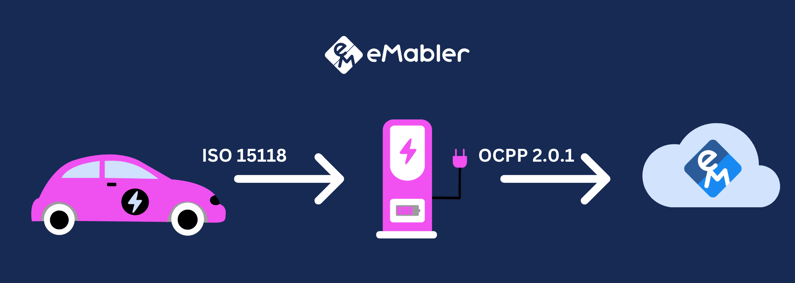Is the time right for OCPP 2.0.1?
What is OCPP?
OCPP stands for Open Charge Point Protocol, which is a communication protocol used between Electric Vehicle (EV) charging stations and Charging Point Management Systems (CPMS). The protocol defines how these two devices communicate with each other to start, stop, and manage charging sessions. In this blog, we'll take a look at the differences between OCPP 1.6 and 2.0.1, and how they impact EV charging.
OCPP 1.6 was released in 2011, and it quickly became the industry standard for EV charging communication. It was designed to provide a basic level of communication between charging stations and CPMS, with a focus on reliability and ease of use. OCPP 1.6 has been widely adopted by the EV charging industry and is still in use today.
OCPP 2.0.1, on the other hand, is a newer version of the protocol that was released in 2018. It was designed to address some of the limitations of OCPP 1.6 and to provide more advanced features for EV charging.
There are some changes in OCPP 2.0.1 that are not supported by OCPP 1.6, such as the introduction of new messages, parameters, and profiles. This means that a charging station or CPMS that supports OCPP 2.0.1 may not be able to communicate with one that only supports OCPP 1.6.
What is new?
So, what are the differences between OCPP 1.6 and 2.0.1? Let's take a look at some of the key features of each protocol.
- Security One of the major improvements in OCPP 2.0.1 is its focus on security. The protocol includes support for secure communication between charging stations and CPMS using Transport Layer Security (TLS). This ensures that all data transmitted between the two devices is encrypted and cannot be intercepted or tampered with. OCPP 2.0.1 also includes support for digital signatures, which allows CPMS to verify that commands received from charging stations are authentic and have not been modified.
- Smart Charging OCPP 2.0.1 includes support for smart charging, which allows charging stations to communicate with CPMS to optimize charging based on factors such as grid demand, energy prices, and user preferences. This can help to reduce peak demand and balance the load on the grid, leading to a more efficient and sustainable charging infrastructure.
- Firmware Management OCPP 2.0.1 includes support for firmware management, which allows charging stations to be updated remotely with new software and firmware. This makes it easier to maintain and update large networks of charging stations, without the need for manual intervention.
- Multi-Protocol Support OCPP 2.0.1 includes support for multiple communication protocols, including the ISO 15118 standard for plug-and-charge functionality. This allows EVs to communicate directly with charging stations without the need for a separate authentication step, making the charging process faster and more convenient for users.

One of the significant changes in OCPP 2.0.1 is the introduction of the Device Model. The Device Model is a new feature that defines the physical properties and capabilities of a charging station, such as the number of connectors, their power ratings, and the types of connectors supported.
The Device Model provides a standardized way of describing charging stations, which makes it easier for CPMS and other software systems to communicate with them. It also enables advanced features such as dynamic load management, where the CPMS can adjust the power delivered to a charging station based on its Device Model, the current state of the grid, and other factors.
In addition to the Device Model, OCPP 2.0.1 includes a new set of profiles that define specific use cases for EV charging, such as Plug and Charge, energy management, and Local Authorization List Management. These profiles provide a standardized way for charging stations and CPMS to communicate about specific use cases, which makes it easier to develop and deploy advanced features in the EV charging ecosystem.
Conclusion
Overall, the introduction of the Device Model and new profiles in OCPP 2.0.1 represents a significant step forward in the standardization of EV charging communication. By providing a standardized way of describing charging stations and specific use cases, OCPP 2.0.1 makes it easier to develop and deploy advanced features that can improve the security, efficiency, reliability, and sustainability of EV charging infrastructure.
We also expect the availability of new services such as Plug and Charge, improved energy management and Local Authorization List Management to be significant reasoning to start using OCPP 2.0.1 capable hardware.
A reliable and user-friendly platform can help EV charging operators and service providers to manage their charging infrastructure more efficiently, which can lead to increased uptime, improved customer satisfaction, and reduced operational costs.
We at eMabler have already implemented the latest version of the OCPP standard, as we see the time is right for OCPP 2.0.1 hardware. Also implementing this now will make it more agile to introduce the upcoming technologies like ISO15118, IEC63110 etc.
eMabler
Based in Helsinki, Finland. We believe that eMobility is the way forward, having worked in the industry for over a decade and we see a great boom in eMobility. We’ve also seen many platform providers develop closed ecosystems and realized that there’s a need for a more flexible solution that focuses on end-user experience.
That’s why we decided to build an open platform that lets you integrate your EV charging data into any existing systems, please contact us.




COMMENTS